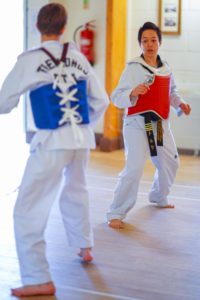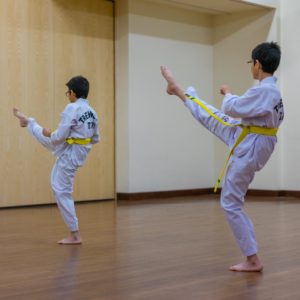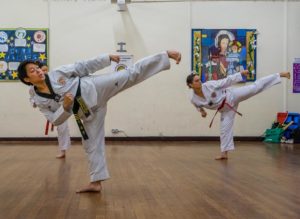USEFUL TO KNOW
Click here to view upcoming TTA and club events

Tenets of Taekwondo
Courtesy
Integrity
Perseverance
Self Control
Indomitable Spirit
Oath of Taekwondo
I shall observe the Tenets of Taekwondo
I shall respect my Instructor and Seniors
I shall never misuse Taekwondo
I shall be a champion of freedom and justice
I shall build a more peaceful world

Etiquette & Rules
Students must adhere to the organisation rules in order to maintain a high standard of etiquette and discipline.
It should be understood by members that the purpose of these rules is primarily to ensure maximum benefit for the study of Taekwondo. These rules have been part of Taekwondo from its inception.
- Bow to your instructor when entering and leaving the school. This is to show respect and your modesty.
- Do not enter or leave the class without permission from your instructor.
- Students must always bow before speaking to the instructor and use words of consideration such as yes or no Sir, pardon me, etc.
- All students are expected to be courteous and understanding. Advanced students are to set an example to new students and to assist such students whenever necessary.
- Loud conversation, laughing in excess, smoking and chewing gum have no place in a Taekwondo school.
- Your uniform should be clean and pressed at all times
- Exchange greetings between students to create a friendlier atmosphere.
- Any substitute teacher shall be treated as would your regular instructor.
- When standing in line, stand to the left or behind a student of a higher grade.
- Do not engage in any activity that might degrade the code of Taekwondo ethics or the reputation of the school
- Do not talk to other students while your instructor is teaching or speaking.
- Ask questions to your instructor to clear up any difficulties.
- When returning after a period of absence, the student must seek the permission of the instructor before commencing training. Students who cannot attend class for one week or more should notify their instructor.
- When seated on the floor, knees should be tucked and hands should be on the knees.
- Students must remove all jewellery from their person before entering the Dojang to begin practice.
- Fingernails and toenails should be clipped short to prevent any injury. All students must observe a high degree of personal hygiene.
- Tuition, grading fees and license fees must be paid on time.

The Belts
White (10th - 9th kup)
Represents the INNOCENCE of the beginner who does not yet have any knowledge of Taekwondo
Yellow (8th - 7th kup)
Represents the EARTH in which the seed of Taekwondo is planted, symbolising a student’s latent abilities.
Green (6th - 5th kup)
Represents a GROWING SHOOT, symbolising the student’s abilities as they start to develop.
Blue (4th - 3rd kup)
Represents the HEAVENS or SKY towards which the shoot is reaching, as the student attempts to reach beyond competence to excellence.
Red (2nd -1st kup)
Represents DANGER, a warning to the student to excercise self-control and for opponents to beware.
Black (1st dan and above)
Represents MATURITY, the opposite of the innocence of the White Belt.
Patterns (poomsae)
Patterns are prearranged sequences of attack and defence moves against imaginary opponents. They are designed to improve power, accuracy and speed and to make techniques reflex actions rather than the result of (Slow) conscious thought. The names of the patterns for the coloured belt grade (kup) students is from the TAE GEUK (Tal Chi, in Chinese), the ultimate principle in oriental philosophy. TAE means “great” and GEUK means “ultimate” or “eternal”. Each pattern represents one of the Eight Trigrams (Pal Gwe) of the I Chin- (The book of Changes).

Colour Belt Patterns
SAJU CHIREUGI (10th kup)
Four-directional punching; 14 movements
KIBON POOMSE (9th kup)
Basic pattern; 20 movements
TAE GEUK IL JANG (8th kup)
Represents HEAVEN and LIGHT (Keon); 18 movements; perform clearly and methodologically, but fluently
TAE GEUK EE JANG (7th kup)
Represents JOYFULLNESS (Tae); 18 movements; perform gently but forcefully
TAE GEUK SAM JANG (6th kup)
Represents FIRE and SUN (Ri); 20 movements; perform with vitality and passion
TAE GEUK SA JANG (5th kup)
Represents THUNDER (Jin); 20 movements; perform with strength and power
TAE GEUK O JANG (4th kup)
Represents WIND (Seon); 20 movements; perform alternately as slow/graceful and strong/fast
TAE GEUK YUK JANG (3rd kup)
Represents WATER (Gam); 23 movements; perform fluidly and steadily
TAE GEUK CHIL JANG (2nd kup)
Represents MOUNTAIN (Gan); 25 movements; perform with stability but free movement
TAE GEUK PAL JANG (1st kup)
Represents EARTH (Gon); 24 movements; perform with strength and unbending force

KORYO (1st dan)
Name of a Korean dynasty (918 – I392 AD); 27 movements
KEUM GANG (2nd dan)
DIAMOND ; suggesting great strength; 27 movements
TAE BAEK (3rd dan)
Old name of Baek Doo, highest mountain in Korea and site of mythical founding of Korea by Dan Gun; 26 movements
PYONG WON (4th dan)
PLAIN ; 31 movements
SIP JIN (5th dan)
DECIMAL ; 31 movements
JITAE (6th dan)
EARTH ; 28 movements
CHON KWON (7th dan)
SKY ; 27 movements
HAN SOO (8th dan)
WATER ; 27 movements
ILYO (9th dan)
ONENESS ; 27 movements
